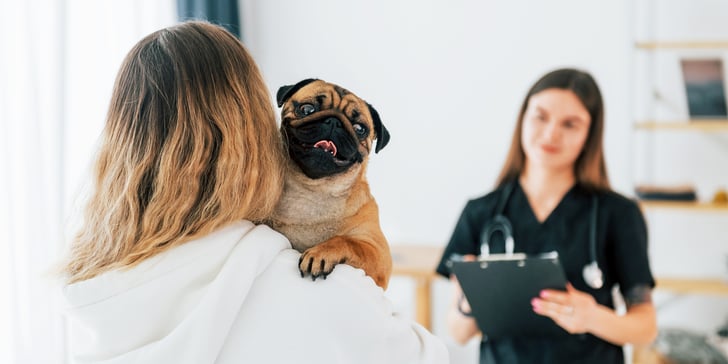Pug Health Issues: Common Problems, Breathing Troubles, Eye Issues and Vet Costs Explained
Index:



The delights of the Pug
Having a Pug is such a delight, but this charming breed sometimes faces unique health problems because of its brachycephalic face shape.
Many pet owners know that choosing the right breeder can make a big difference. The health issues faced by these dogs means that a classic flat face can also come with challenges.
One might even say it creates a much higher risk for their respiratory system due to a tight nostril and resulting breathing difficulties.
If you want to understand these challenges and help your pet live a happy life, keep reading; we have caring tips and practical advice for all new and existing Pug parents.
We know that your love for your furry friend drives you to be their best advocate.
The information below will help you get a handle on what to watch for and how to manage these issues so that your beloved pet stays comfortable and healthy.
Key takeaways
Pugs have a unique physical structure that can lead to special health issues.
Breathing difficulties, eye problems, and joint issues are common concerns.
Early detection and regular vet visits can help manage these conditions.
Understanding the costs involved can prepare owners for potential expenses.
Practical tips and care routines can keep your Pug happier longer.



Understanding common Pug health issues
Many Pug owners share similar worries about their tiny friends. While these dogs bring joy with their playful nature, their body structure sometimes causes problems.
Whether it is breathing issues or eye conditions, each health concern comes with its own warning signs and management strategies. We also need to talk about the importance of a proper diet, exercise, and gentle care routines.
Breathing difficulties and brachycephalic challenges
As stated, one of the most talked-about challenges is breathing difficulties. Pug owners often notice their pet struggling to catch a full breath during play.
This is most commonly due to the condition known as brachycephalic obstructive airway syndrome (BOAS).
In simple terms, the dog’s short snout leads to a narrowed airway, making it hard for air to reach the lungs. Even minor activities can feel exhausting for them.
In some cases, the solution might be a minor surgery like nostril widening or palate trimming. Though such procedures might sound intimidating, they can greatly improve your pet’s quality of life.
Regular vet check-ups help monitor these issues. And if you ever feel overwhelmed, remember that a well-informed owner is the best advocate for a happy pet.
Eye issues: dry eye and entropion
Another common issue is eye problems. Pugs can suffer from dry eye or entropion, where the eyelids roll inward.
Dry eye, medically known as Keratoconjunctivitis Sicca, leads to discomfort and potential damage if not treated with regular medicated drops. Meanwhile, entropion in these little charmers often requires surgical correction to prevent painful irritation.
Eye conditions can sometimes be mistaken for normal aging. It pays to be vigilant and notice changes in your pet’s behaviour such as frequent blinking or squinting.
Simple daily routines like carefully cleaning around the eye area can make a big difference in managing these issues.
Other health challenges for your Pug
Pugs are also prone to several other conditions. For instance, the risk of skin infections is high due to moisture in their skin folds.
Joint issues like patellar luxation or hip dysplasia can affect mobility, while heat sensitivity is another serious concern.
Pugs can comfortably overheat on hot days, so always ensure they have access to cool spaces and plenty of fresh water.
A good tip is to carve out time for gentle exercise and cooling measures. This can mean a shaded walk on a mild day or simply keeping them indoors during peak heat hours. While the list of potential issues may seem long, early detection and vigilant care are key.



Treatment costs and managing your Pug’s health
It's not just an emotional journey caring for a Pug, but there can also be a financial side to consider. Veterinary bills might seem daunting, so looking at estimated treatment costs can help you budget and prepare for the future.
Understanding what a procedure might cost means fewer surprises on a vet visit.
Note: Costs are approximate and can vary based on location and specific veterinary practices.
Practical tips for managing Pug health
Keeping your Pug happy and healthy involves daily care, exercise, and regular check-ups. It is all about routine and observation.
Small changes in behaviour or energy levels could be early signs of bigger issues. Stay aware, and never hesitate to consult your vet if something seems off.
Simple adjustments in diet, cooling periods during summer, or regular grooming sessions can make a noticeable difference.
For example, when it comes to grooming, effective cleaning of skin folds, ears, and the eye area can prevent skin infections and other discomforts.
There are plenty of helpful articles out there , including our tips on grooming your pug. Regular physical checks also help monitor weight and overall well-being, which is especially essential if your Pug shows signs of joint pain.
Also, check out this Pug dog breed temperament guide to learn more about your companion's nature.
Additional ways to stay ahead
Monitor your Pug’s energy and breathing patterns during play.
Keep a regular schedule for vet check-ups and grooming sessions.
Ensure your Pug gets a balanced diet to maintain a healthy weight.
Be mindful of weather changes and keep your pet comfortably cool.
Watch for early signs of discomfort in eyes or joints.



Staying informed and connected
The world of pet care is always evolving. Whether it's a new grooming technique or a breakthrough in treating common Pug conditions, staying informed can be a game-changer.
You might even join local groups or online communities to share advice and learn from other Pug lovers.
Remember, your Pug is more than just a pet, they are a valued part of your family. As you follow care guidelines and monitor for any red flags, you are ensuring a better quality of life for your friend.
After all, each little moment with your furry companion is precious, and a bit of extra care makes those moments even sweeter.
If reading about Pug care has inspired you to dive deeper into the world of pet parenting, consider exploring how pets as family members can brighten your everyday life.
We hope you find these tips helpful and that the information here makes managing your Pug's unique needs a little easier.
Our goal is to support you on this rewarding journey, one wag and snuggle at a time.
Waggel Pet Insurance
Need more help? You're in luck if you're a Waggel Pet Insurance member. Along with our excellent coverage, we offer access to a 24/7 online vet to answer all your sticky questions, especially if you need grooming assistance.
Not a member? Why not get a quote now and cover your furry friend for a range of illnesses, all while enjoying our amazing perks and rewards.
Want more like this?
Get updates from us with helpful info, advice, answers to frequently asked questions and much more.
Index:
Related posts:
Get your quote
Along with our excellent coverage, we offer access to a 24/7 online vet to answer all your sticky questions.





